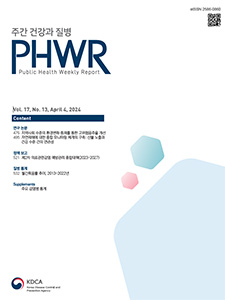Current Issue
Vol.17 No.13, April 04, 2024
-
Original Articles 2024-04-04
 0
0
 511
511
 312
312
Reduction of High-risk Drinking Prevalence through Community-based Environmental Change Interventions
Sun-Jin Jo, Byeongchan Seong, Hae Kook Lee, Sooyeon Han, Yun Jae Shin, Hyeongae Bang, Myoung Hee Bang, Jangrae Kim, Soo Bi Lee, MiHyun Kim, Min Park, Jongtae Kim
Public Health Weekly Report 2024; 17(13): 475-494 https://doi.org/10.56786/PHWR.2024.17.13.1 Abstract
AbstractThis study evaluated the short-term impact of a community-based environmental intervention for the reduction of high-risk drinking prevalence in a Seoul district since 2021. The evidence-based intervention relies on collaboration among various sectors and entities in the local community. Comparing high-risk drinking prevalence between the intervention and control areas between 2020 and 2022, the intervention area shows a 10.8% decrease, while the control area exhibits a 7.0% increase. These results suggest the intervention’s potential impact on reducing the region’s high-risk drinking prevalence. Therefore, there is a need to explore the impact of an environmental change approach at the metropolitan government level to reduce the prevalence of high-risk drinking for the promotion of overall health in Seoul.
-
Original Articles 2024-04-04
 0
0
 386
386
 138
138
Establishing a Comprehensive Monitoring System for Natural Disasters: The Associations between Wildfire Exposure and Health Outcomes
Heejoo Park, Byungyoon Yun, Juho Sim, Juyeon Oh, Yangwook Kim, Jongmin Lee, Jin-ha Yoon
Public Health Weekly Report 2024; 17(13): 495-520 https://doi.org/10.56786/PHWR.2024.17.13.2 Abstract
AbstractThis study examines the health impacts of a 2017 wildfire on residents in both exposed and non-exposed areas, highlighting the increasing importance of health consequences related to natural disasters in contemporary society. The research utilizes retrospective data to compare health outcomes before and after the wildfire, between the two groups. Health impacts are assessed through rates of outpatient visits and hospitalizations, with a focus on conditions such as congestive heart failure, chronic obstructive pulmonary disease, and pneumonia in the exposed area. The study conducted rapid analysis using advanced techniques, including the double-difference method and time series analysis, to identify significant changes and outcomes. Expert consultations and the Delphi method enhanced the accuracy of the analysis, aiding in the identification of vulnerable areas and health conditions. The research emphasizes the importance of collaboration with various agencies to secure data during the pre-preparedness phase and recommends proactive on-site investigations and tracking and observation protocols during retrospective analysis. In the response phase, the focus was on rapid data collection, advanced analysis identification of high-risk populations in exposed areas, and precise tracking and response strategies. Furthermore, the study suggests the potential for proposing legislative measures to support residents in exposed areas. The establishment of a comprehensive and systematic monitoring system based on the findings of this research, is expected to contribute to a deeper understanding of natural disaster exposure and its associated health impacts, as well as to the development of effective response strategies.
-
Policy Notes 2024-04-04
 1
1
 903
903
 545
545
The 2nd National Action Plan for Prevention and Control of Healthcare-Associated Infections (2023–2027)
Hoon Cho, Yeon-hee Woo, Sook-kyung Park*
Public Health Weekly Report 2024; 17(13): 521-531 https://doi.org/10.56786/PHWR.2024.17.13.3 Abstract
AbstractOn April 12, the Korea Disease Control and Prevention Agency unveiled ‘The 2nd National Action Plan for the Prevention and Control of Healthcare-Associated Infections (2023–2027).’ This initiative aims to foster a safer healthcare environment against infections by addressing the shortcomings of ‘ The 1st National Action Plan for the Prevention and Control of Healthcare-Associated Infections (2018–2022),’ and establishing an enhanced national-level infection prevention and control system, reflecting the changed conditions in medical settings since coronavirus disease 2019.
-
QuickStats 2024-04-04
 0
0
 452
452
 160
160
Trends in the Prevalence of Binge Drinking, 2013–2022
Public Health Weekly Report 2024; 17(13): 532-533 https://doi.org/10.56786/PHWR.2024.17.13.4

pp. 1~2097
Most Keyword
?
What is Most Keyword?
- It is the most frequently used keyword in articles in this journal for the past two years.
Most Read
-
Waterborne and Foodborne Disease Outbreaks in the Republic of Korea, 2023
Myung-Jae Hwang, So Yeon Park, Hyungjun Kim, Se Jeong Yang, Sungchan Yang, Jin Seon Yang
Public Health Weekly Report 2025;18: 17-32 https://doi.org/10.56786/PHWR.2025.18.1.2 -
Implementation Plan for the Coronavirus Disease 2019 Vaccination for the 2024–2025 Season: Recommendations of the 6th Expert Committee on Immunization Practices
Hyewook Hwang, Wookeon Lee, Seohyeon Ahn, Young-Sook Choi, Seunghyun Lewis Kwon, Dongwoo Lee, Eun Hwa Choi, SokGoo Lee
Public Health Weekly Report 2025;18: 90-102 https://doi.org/10.56786/PHWR.2025.18.2.3
Editorial Office
+82-43-719-7569





 Full Text
Full Text Cite
Cite


